List of destroyed libraries
Libraries have been deliberately or accidentally destroyed or badly damaged. Sometimes a library is purposely destroyed as a form of cultural cleansing.[1]
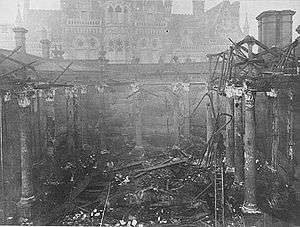
There are examples of accidentally destroyed libraries by human actions. Other times they are damaged by natural disasters like earthquakes, floods or accidental fires.
Library fires have happened sporadically through the centuries: notable examples are the destruction of the Library of Alexandria, destruction of Library of Nalanda in India and the accidental burning of the Duchess Anna Amalia Library in Weimar. Causes vary from arson to the sun's rays setting fire to leaflets through the action of a magnifying lens, as happened to a library in Northam, Devon.[2][3]
Causes and prevention
In earlier times mildew was considered a major problem in many libraries and so the emphasis on library design was to increase air flow by, for example, leaving openings under the shelves in adjoining floors. In a fire the flames will be drawn floor to floor by the air flow thus ensuring the relatively easy destruction of a whole library rather than a small section.
Advances in technology have reduced the possibility of a library collection being destroyed by fire. These include water sprinklers, fire doors, freezers, alarms, smoke detectors, suppression systems, and emergency generators. Older libraries are usually converted by closing up air flow openings and installing fire doors, alarms and sprinklers. Air conditioning reduces the mold problems. These are all essential parts of new library design.
There is no recovery possible if a book is burnt so it is accepted that a better solution is to put out the fire with water and then dry out the books. As mold destroys paper the books are frozen until they can be dried. This process will damage the book but not destroy it and the information will be intact.
In order to minimize the possibility of damage from fire, or other causes, and decrease the time needed for recovery after a destructive event, all libraries need a disaster management and recovery plan. This can be an ongoing process which will include professional development following updates in technology for key staff, training for the remaining staff, checking and maintaining disaster kits, and review of the disaster plan.
In addition, fire-safety investigations are periodically carried out, especially regarding historical libraries. The Library of Congress, for example, experienced a year-long inspection in 2000. Before the Congressional Accountability Act of 1995, the Library of Congress and all Capitol Hill buildings were exempt from safety regulations.[4] Balancing historical preservation and contemporary safety standards proves to be a difficult task for "even a 12-year rehabilitation of LC completed in 1997 did not address many fire hazards".[5] After the Compliance Office inspection, however, the LC announced their wholehearted commitment "to achieving the highest level of safety possible" and "the Architect of the Capitol and Library of Congress will report their progress to the Office of Compliance every three months".[4]
Information technology is another catalyst for careful fire protection. With so many computers in libraries there "is a decrease in floor space and an increase in more compact and powerful computer systems" which generates more heat and requires the use of many more outlets, increasing the number of potential ignition sources.[6] From as early as the 1950s the potential dangers of computer equipment, and the facilities that house them, was recognized. Thus in 1962 the National Fire Protection Association began developing the first safety standards specifically applicable to electronic computer systems.[6] This standard is called NFPA 75 Protection of Information Technology Equipment. FM Global Data Sheet 5–32 is another standard providing guidelines to protect against not only fire, but water, power loss, etc.[6]
Human action
| Image | Name of Library | City | Country | Date of Destruction | Perpetrator | Reason and/or Account of Destruction |
|---|---|---|---|---|---|---|
 |
Xianyang Palace and State Archives | Xianyang | Qin China | 206 BC | Xiang Yu | Xiang Yu, rebelling against emperor Qin Er Shi, led his troops into Xianyang in 206 BC. He ordered the destruction of the Xianyang Palace by fire.[7] (Qin Shi Huang had ordered the burning of books and burying of scholars earlier.) |
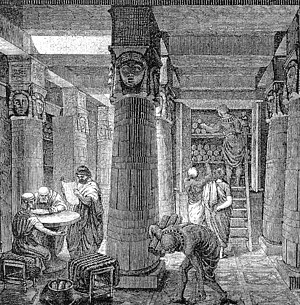 |
Library of Alexandria | Alexandria | Ancient Egypt | Disputed | Disputed | Disputed,[8][9] see destruction of the Library of Alexandria. |
| Library of Antioch | Antioch | Ancient Syria | 364 AD | Emperor Jovian[10] | The library had been heavily stocked by the aid of the perpetrator's non-Christian predecessor, Emperor Julian (the Apostate). | |
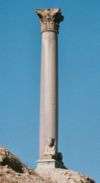 |
Library of the Serapeum | Alexandria | Ancient Egypt | 392 | Theophilus of Alexandria | The library was burned and looted at the perpetrator's decree, who was ordered to do so by Theodosius I. |
| Library of al-Hakam II |
Córdoba | Al-Andalus | 976 | Al-Mansur Ibn Abi Aamir & religious scholars | All books consisting of "ancient science" were destroyed in a surge of ultra-orthodoxy.[11][12] | |
| Library of Rayy | Rayy | Buyid Emirate | 1029 | Sultan Mahmud of Ghazni | Burned the library and all books deemed as heretical.[13] | |
| Library of Avicenna | Isfahan | Kakuyid Emirate | 1034 | Sultan Mas'ud I | After conquering the city of Isfahan, the library of Avicenna was destroyed.[14] | |
| Library of Banu Ammar (Dar al-'ilm) | Tripoli | Fatimid Caliphate | 1109 | Crusaders | Following Sharaf al-Daulah's surrender to Baldwin I of Jerusalem, Genoese mercenaries burned and looted part of the city. The library, Dar al-'ilm, was burned.[15] | |
| Library of Ghazna | Ghazna | Ghurid empire | 1151 | 'Ala al-Din Husayn | City was sacked and burned for seven days. Libraries and palaces built by the Ghaznavids were destroyed.[14] | |
| Library of Nishapur | Nishapur | Seljuk Empire | 1154 | Oghuz Turks | City partially destroyed, libraries sacked and burned.[16] | |
 |
Nalanda | Nalanda | India | 1193 | Bakhtiyar Khilji | Nalanda University complex (the most renowned repository of Buddhist knowledge in the world at the time) was sacked by Turkic Muslim invaders under the perpetrator; this event is seen as a milestone in the decline of Buddhism in India.[17] |
| Imperial Library of Constantinople | Constantinople | Byzantine Empire | 1204 | The Crusaders | In 1204, the library became a target of the knights of the Fourth Crusade. The library itself was destroyed and its contents burned or sold. | |
| Alamut Castle's library | Alamut Castle | Iran | 1256 | Mongols | Library destroyed after the capture of Alamut Castle.[18] | |
| House of Wisdom | Baghdad | Iraq | 1258 | Mongols | Destroyed during the Battle of Baghdad[19] | |
| Libraries of Constantinople | Constantinople | Byzantine Empire | 1453 | Ottoman Turks | After the Fall of Constantinople, hundreds upon thousands of manuscripts were removed, sold, or destroyed from Constantinople's libraries.[20] | |
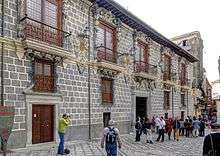 |
Madrassah Library | Granada | Crown of Castile | 1499 | Cardinal Cisneros | The library was ransacked by troops of Cardinal Cisneros in late 1499, the books were taken to the Plaza Bib-Rambla, where they were burned.[21] |
| Bibliotheca Corviniana | Buda | Hungary | 1526 | Ottoman Turks | Library was destroyed by Ottomans in the Battle of Mohács.[22] | |
| Monastic libraries | England | England | 1530s | Royal officials | The monastic libraries were destroyed or dispersed following the dissolution of monasteries by Henry VIII. | |
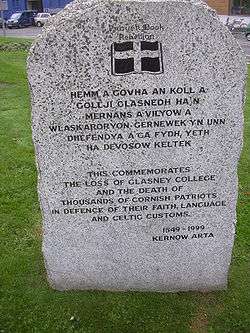 |
Glasney College | Penryn, Cornwall | England | 1548 | Royal officials | The smashing and looting of the Cornish colleges at Glasney and Crantock brought an end to the formal scholarship which had helped to sustain the Cornish language and the Cornish cultural identity. |
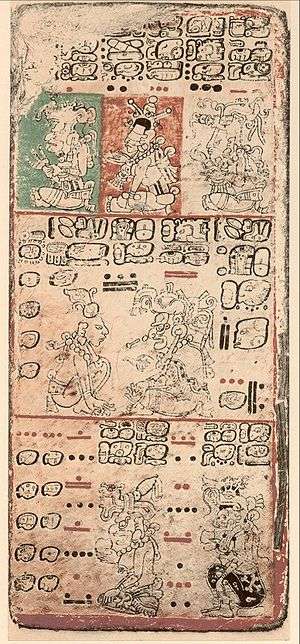 |
Maya codices of the Yucatán | Maní, Yucatán | Mexico and Guatemala | 1562-07-12 | Diego de Landa | Bishop De Landa, a Franciscan monk and conquistador during the Spanish conquest of Yucatán, wrote: "We found a large number of books in these characters and, as they contained nothing in which were not to be seen as superstition and lies of the devil, we burned them all, which they (the Maya) regretted to an amazing degree, and which caused them much affliction." Only three extant codices are widely considered unquestionably authentic. |
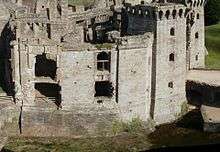 |
Raglan Library | Raglan Castle | Wales | 1646 | Parliamentary Army | The Earl of Worcester's library was burnt during the English Civil War by forces under the command of Thomas Fairfax |
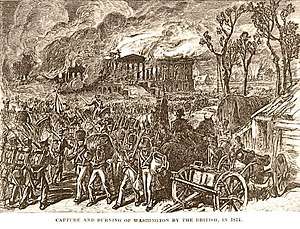 |
Library of Congress | Washington, D.C. | United States | 1814 | Troops of the British Army | The library was destroyed during the War of 1812 when British forces set fire to the U.S. Capitol during the Burning of Washington.[23] This attack was retaliation for the burning of the Canadian towns of York and Niagara by American troops in 1813.[24] Soon after its destruction, the Library of Congress was reestablished, largely thanks to the purchase of Thomas Jefferson's personal library in 1815. A second fire on December 24th, 1851 destroyed a large portion of the Library of Congress' collection again, however, resulting in the loss of about two-thirds of the Thomas Jefferson collection and an estimated 35,000 books in total.[25] |
| Several libraries | Mexico City and major Mexican cities | Mexico | 1856-1867 | Liberal troops and anti-clericalists | During and after the Mexican Reform War, under the liberal governments of Benito Juárez and Ignacio Comonfort, many convent libraries and Church owned school libraries were sacked or destroyed by Liberal troops and looters, most notably included San Francisco Convent Library, which had over 16,000 books (great majority of them were unique collections of Spanish colonial era productions), the library was totally destroyed. Other important libraries included San Agustín Convent Library, was looted and burned. The Carmen de San Ángel Convent and its library were also totally destroyed (with a few books recovered), other affected convent libraries to different degrees were those of Santo Domingo, Las Capuchinas, Santa Clara, La Merced and the Church owned school Colegio de San Juan de Letrán, among others, all of them in Mexico City. Similar events happened all over Mexico, espcially in major cities. Besides books, other items such as altarpieces, unique collections of colonial period Baroque paintings, crosses, sculptures, gold and silver chalices (often robbed and melted) were also lost. Total estimates place the total of lost books and manuscripts at 100,000 by 1884.[26][27] | |
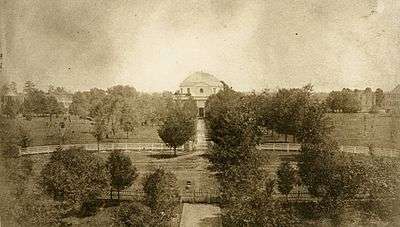 |
University of Alabama | Tuscaloosa, Alabama | United States | 1865-05-04 | Troops of the Union Army | During the American Civil War, Union troops destroyed most buildings on the University of Alabama campus, including its library of approximately 7,000 volumes.[28] |
| Mosque-Library | Turnovo, Bulgaria | Ottoman Empire | 1877 | Christian Bulgarians | Turkish books in a library were destroyed when the mosque was burned.[29] | |
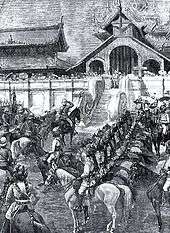 |
Royal library of the Kings of Burma | Mandalay Palace | Burma | 1885–1887 | Troops of the British Army | The British looted the palace at the end of the 3rd Anglo-Burmese War (some of the artefacts which were taken away are still on display in the Victoria and Albert Museum in London)[30] and burned down the royal library. |
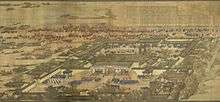 |
Hanlin Academy Library | Hanlin Academy | China | 1900-06-23/4 | Disputed. Possibly the Kansu Braves besieging the west of the Legation Quarter, or possibly by the international defending forces. | During the Siege of the International Legations in Beijing at the height of the Boxer Rebellion, the unofficial national library of China at the Hanlin Academy, which was adjacent to the British Legation, was set on fire (by whom and whether deliberately or accidentally is still disputed) and almost entirely destroyed. Many of the books and scrolls that survived the flames were subsequently looted by forces of the victorious foreign powers. |
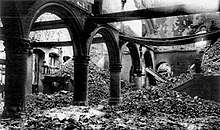 |
Library of the Catholic University of Leuven | Leuven | Belgium | 1914-08-25 | German Occupation Troops | The Germans set the library on fire as part of the burning of the entire city in an attempt to use terror to quell Belgian resistance to occupation.[31] |
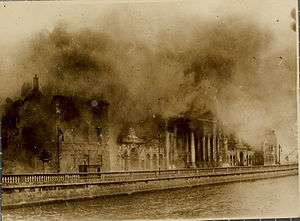 |
Public Records Office of Ireland | Dublin | Ireland | 1922 | Disputed. Poss. deliberately by Anti-Treaty IRA or accidental ignition of their stored explosives due to shelling by Provisional Government forces.[32] | The Four Courts was occupied by the Anti-Treaty IRA at the start of the Irish Civil War. The building was bombarded by the Provisional Government forces under Michael Collins.[33] |
.png) |
Several religious libraries | Madrid | Spain | 1931 | Anarchists and anti-clericalists | In 1931, several groups of radical leftists and anarchists, with the complicit inaction of the Republican government, burned down several convents in Madrid. Most included important libraries. Among them, the Colegio de la Inmaculada y San Pedro Claver and the Instituto Católico de Artes e Industrias with a library of 20 000 volumes; the Casa Profesa with a library of 80 000 volumes, considered the second best in Spain at the time, after the National Library; and the Instituto Católico de Artes e Industrias, with 20 000 volumes, including the archives of the paleographer García Villada, and 100 000 popular songs compiled by P. Antonio Martínez. Everything was lost. |
 |
Oriental Library (also known as Dongfang Tushuguan) | Zhabei, Shanghai | China | 1932-02-01 | Imperial Japanese Army | During the January 28 incident in the Second Sino-Japanese War Japanese forces bombed The Commercial Press and the attached Oriental Library, setting it alight and destroying most of its collection of more than 500,000 volumes.[34][35][36] |
| Institut für Sexualwissenschaft | Berlin | Nazi Germany | 1933-05-?? | Members of the Deutsche Studentenschaft | On 6 May 1933, the Deutsche Studentenschaft made an organised attack on the Institute of Sex Research. A few days later, the Institute's library and archives were publicly hauled out and burned in the streets of the Opernplatz. | |
| National University of Tsing Hua, University Nan-k'ai, Institute of Technology of He-pei, Medical College of He-pei, Agricultural College of He-pei, University Ta Hsia, University Kuang Hua, National University of Hunan | China | 1937–1945 | World War II Japanese Troops | During World War II, Japanese military forces destroyed or partly destroyed numerous Chinese libraries, including libraries at the National University of Tsing Hua, Peking (lost 200,000 of 350,000 books), the University Nan-k'ai, T'ien-chin (totally destroyed, 224,000 books lost), Institute of Technology of He-pei, T'ien-chin (completely destroyed), Medical College of He-pei, Pao-ting (completely destroyed), Agricultural College of He-pei, Pao-ting (completely destroyed), University Ta Hsia, Shanghai (completely destroyed), University Kuang Hua, Shanghai (completely destroyed), National University of Hunan (completely destroyed).[37] | ||
 |
Library of the Catholic University of Leuven | Leuven | Belgium | 1940-05-?? | German Occupation Troops | Caught fire during German invasion of Louvain, Belgium.[38] |
| National Library of Serbia | Belgrade | Yugoslavia | 1941-04-06 | Nazi German Luftwaffe | Destroyed during the World War II bombing of Belgrade, on the order of Adolf Hitler himself.[39] Around 500.000 volumes and all collections of the library were destroyed in one of the largest book bonfires in European history.[40] | |
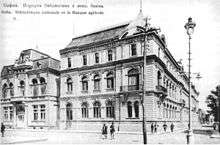 |
SS. Cyril and Methodius National Library | Sofia | Bulgaria | 1943–1944 | Allied bombing Allied air forces | |
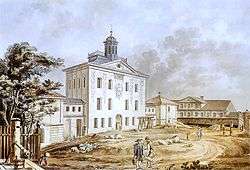 |
Załuski Library | Warsaw | Poland | 1944 | Nazi German troops | The library was burned down during the Nazi suppression of the Warsaw Uprising of 1944. The burning of this library was part of the general setting on fire of a large part of the city of Warsaw.[41] |
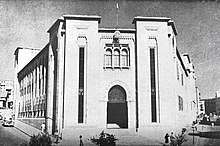 |
Lebanese National Library | Beirut | Lebanon | 1975 | Lebanese Civil War | The 1975 war fighting began in Beirut's downtown where the National Library was located. During the war years, the library suffered significant damage. According to some sources, 1200 of most precious manuscripts disappeared, and no memory is left of the Library's organization and operational procedures of that time. |
.jpg) |
National Library of Cambodia | Phnom Penh | Cambodia | 1976–1979 | The Khmer Rouge[37] | Burnt most of the books and all bibliographical records. Only 20% of materials survived.[37] |
| Jaffna Public Library | Jaffna | Sri Lanka | 1981-05-?? | Plainclothes police officers and others | In May 1981, a mob composed of thugs and plainclothes police officers went on a rampage in minority Tamil-dominated northern Jaffna, and burned down the Jaffna Public Library. At least 95,000 volumes – the second largest library collection in South Asia – were destroyed.[42] | |
| Sikh Reference Library | Punjab | India | 1984-06-07 | Troops acting under Indira Gandhi's orders | Before its destruction, the library contained rare books and handwritten manuscripts on Sikh religion, history, and culture.[43] It could have been a desperate act on failure to locate letters or documents that could have implicated the then Indian government and its leader Indira Gandhi.[44][45] | |
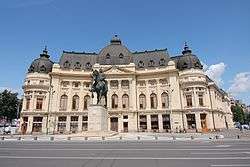 .jpg) |
Central University Library of Bucharest | Bucharest | Romania | 1989-12-2? | Romanian Land Forces | Burnt down during the Romanian Revolution.[46][47] |
| Oriental Institute in Sarajevo | Sarajevo | Bosnia and Herzegovina | 1992-05-17 | Bosnian Serb Army | Destroyed by the shellfire during the Siege of Sarajevo.[48][49][50] | |
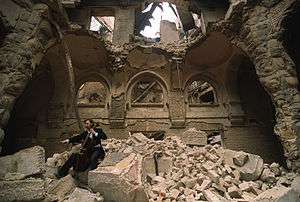 |
National and University Library of Bosnia and Herzegovina | Sarajevo | Bosnia and Herzegovina | 1992-08-25 | Bosnian Serb Army | The library was completely destroyed during the Siege of Sarajevo.[48] |
| Abkhazian Research Institute of History, Language and Literature & National Library of Abkhazia | Sukhumi | Abkhazia | 1992-10-?? | Georgian Armed Forces | Destroyed during the War in Abkhazia.[51] | |
| City library | Linköping | Sweden | 1996-09-20 | Lack of evidence for trial | After a year of repeated, minor arson attempts against an information bureau for immigrants located in the building, the library is eventually burnt down to the ground. | |
| Pol-i-Khomri Public Library | Pol-i-Khomri | Afghanistan | 1998 | Taliban militia | It held 55,000 books and old manuscripts.[52] | |
| Iraq National Library and Archive, Al-Awqaf Library, Central Library of the University of Baghdad, Library of Bayt al-Hikma, Central Library of the University of Mosul and other libraries | Baghdad | Iraq | 2003-04-?? | Unknown members of the Bagdad population | Several libraries looted, set on fire, damaged and destroyed in various degrees during the 2003 Iraq War.[53][54][55][56][57] | |
| The People's Library Occupy Wall Street | Zuccotti Park Lower Manhattan New York City | United States | 2011 | New York City Department of Sanitation | Over 5,000 books cataloged in LibraryThing were seized.[58] | |
| Egyptian Scientific Institute | Cairo | Egypt | 2011-12-?? | Aftermath of street clashes during the Egyptian revolution | A first estimate says that only 30,000 volumes have been saved of a total of 200,000.[59] | |
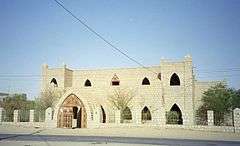 |
Ahmed Baba Institute (Timbuktu library) | Timbuktu | Mali | 2013-01-28 | Islamist militias | Before the library was burned down, it contained over 20,000 manuscripts with only a fraction of them having been scanned as of January 2013. Before and during the occupation, more than 300,000 Timbuktu Manuscripts from the Institute and from private libraries were saved and moved to more secure locations.[60][61][62] |
| Ratanda Public Library | Lesedi Local Municipality | South Africa | 2013-03-12 | Public riots | 1,807 library books, technological infrastructure including seven patron workstations, a photocopy machine and a large screen television. [63] | |
| Libraries of Fisheries and Oceans Canada | Canada | 2013 | Government of Canada headed by prime minister Stephen Harper | Digitization effort to reduce the nine original libraries to seven and save $C443,000 annual cost.[64] Only 5–6% of the material was digitized, and that scientific records and research created at a taxpayer cost of tens of millions of dollars was dumped, burned, and given away.[65] Particularly noted are baseline data important to ecological research, and data from 19th century exploration. | ||
| Saeh Library | Tripoli | Lebanon | 2014-01-03 | Unknown | The Christian library was burned down, it contained over 80,000 manuscripts and books.[66][67][68][69] | |
| National Archives of Bosnia and Herzegovina (partially) | Sarajevo | Bosnia and Herzegovina | 2014-02-07 | Seven Bosnian rioters suspected of having started the fire; two (Salem Hatibović and Nihad Trnka)[70] were arrested.[71] On 4 April 2014, Salem Hatibović and Nihad Trnka were released (although still under suspicion of terrorism), on conditions that they don't leave their places of residence and abstain from having any contact with each other. Both were also mandated to report to the police once every week.[70] |
During the 2014 unrest in Bosnia and Herzegovina large amounts of historical documents were destroyed when sections of the Archives of Bosnia and Herzegovina, housed in the presidential building, were set on fire. Among the lost archival material were documents and gifts from the Ottoman period, original documents from the 1878–1918 Austro-Hungarian rule in Bosnia and Herzegovina, as well as documentations of the interwar period, the 1941–1945 rule of the Independent State of Croatia, papers from the following years, and about 15000 files from the 1996–2003 Human Rights Chamber for Bosnia and Herzegovina.[72][73]
In the repositories that were burnt, about 60 percent of the material was lost, according to estimates by Šaban Zahirović, the head of the Archives.[74] | |
| Mosul University libraries and private libraries |
Mosul | Iraq | 2014-12-?? | Ongoing ISIL book burning | Book burning.[75] | |
| Libraries in Al Anbar Governorate | Al Anbar Governorate | Iraq | 2014-12-?? | Ongoing ISIL book burning | Book burning.[75] | |
.jpg) |
Institute of Scientific Information on Social Sciences (INION) (partially?) | Moscow | Russia | 2015-01-29 | Unknown. | Fire spread to 2000 m² in third Floor. Roof caved in. Additional water damage. Ambient temperature too high for self-freezing of damaged Works. Library contains 14 million books, including rare texts in ancient Slavic languages, documents from the League of Nations, UNESCO, and parliamentary reports from countries including the US dating back as far as 1789.[76] |
| Mosul public library (Central Public Library in Ninawa) |
Mosul | Iraq | 2015-02-?? | ISIL book burning | 8,000 rare old books and manuscripts. Manuscripts from the 18th century, Syriac books printed in Iraq's first printing house in the 19th century, books from the Ottoman era, Iraqi newspapers from the early 20th century.[77] |
Natural disasters
| Image | Name of Library | City | Country | Date of Destruction | Causes and/or Account of Destruction |
|---|---|---|---|---|---|
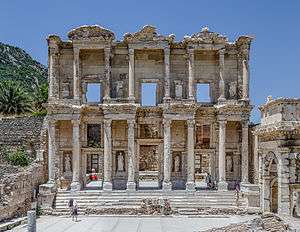 |
Library of Celsus | Ephesus | Roman Empire | 262 | 262 Southwest Anatolia earthquake |
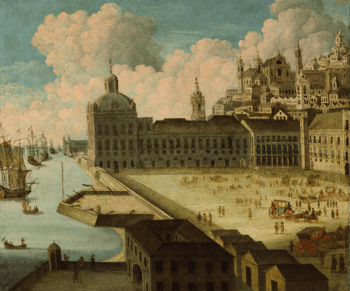 |
Royal Library of Portugal, Ribeira Palace | Lisbon | Portugal | 1755-11-01 | Great Lisbon earthquake |
| Imperial University Library in Tokyo, Max Müller Library, Nishimura Library, Hoshino Library | Japan | 1923-09-01 | An earthquake and the following fires.[37] | ||
| National Library of Nicaragua Rubén Darío | Nicaragua | 1931, 1972 | It was damaged in the 1931 earthquake. Another earthquake in 1972 caused damages; furthermore, it was looted.[78] | ||
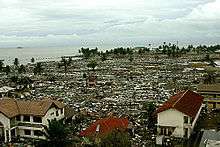 |
Several libraries, archives, and museums | Indonesia, Malaysia, Maldives, Thailand, Sri Lanka | 2004-12-?? | The 2004 Indian Ocean earthquake. See Library damage resulting from the 2004 Indian Ocean earthquake. |
Fire
| Image | Name of Library | City | Country | Date of Destruction | Account of Destruction |
|---|---|---|---|---|---|
| Library of Celsus | Ephesus | Turkey | 262 | ||
| University of Copenhagen Library | Copenhagen | Denmark | 1728 October | Copenhagen Fire of 1728 | |
| Cotton Library | Huntingdon | United Kingdom | 1731-10-23 | ||
| Library of Congress | Washington, D.C. | United States | 1814-08-25 | ||
| Birmingham Central Library | Birmingham | United Kingdom | 1879-01-11 | A fire broke out behind a wooden partition serving as a temporary wall during building operations.[79] The fire caused extensive damage, with only 1,000 volumes saved from a stock of 50,000.[79] | |
| University of Virginia Library | Charlottesville, Virginia | United States | 1895-10-27 | ||
| New York State Library | Albany, New York | United States | 1911-03-29 | ||
| National Library of Peru | Lima | Peru | 1943-05-10 | ||
| Jewish Theological Seminary of America library | New York City | United States | 1966-04-18 | Jewish Theological Seminary library fire | |
| Charles A. Halbert Public Library | Basseterre | Saint Kitts and Nevis | 1982[80] | ||
| Dalhousie University Law Library | Halifax, Nova Scotia | Canada | 1985-08-16 | A lightning strike caused a short in the electrical system which started a fire that destroyed the top floor of the building which housed the library.[81] | |
| Los Angeles Central Library | Los Angeles, California | United States | 1986-04-29 & 1986-09-03 | At 10:52 A.M. on the morning of April 29, 1986, a fire alarm alerted staff and patrons of a fire in the library's main building. Over 350 firefighters responded to the blaze, which burned for about 7 hours. As a result, an estimated 400,000 books were destroyed and an additional 350,000 materials suffered significant amounts of smoke and water damage. Ultimately, the source of the fire was determined to be incendiary and began on the fifth tier of the northeast stack.[82] | |
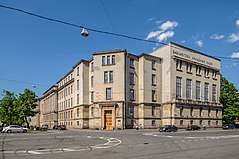 |
Academy of Sciences Library | Leningrad, | USSR | 1988-02-14 | The 1988 fire in the Library of the USSR Academy of Sciences (now Library of the Russian Academy of Sciences) broke out on Sunday, February 14, 1988, in the newspaper section on the third floor of the library. According to the library's acting director Valeriy Leonov, the fire alarm sounded at 8:13 pm, when the library was closed for visitors. By the time the fire was extinguished the following afternoon, it had destroyed between 300,000[83] and 400,000[84] books of the total 12 million housed. About 3.5 million volumes initially became damp due to firefighting foam. |
| Norwich Library – | Norwich, England | United Kingdom | 1994-08-01[85] | On August 1, 1994, Norwich Central Library caught fire due to an electrical fault. Over one hundred firefighters responded as the flames escalated and smoke became visible from twenty miles away. Ultimately, over 100,000 books and thousands of historical documents were destroyed.[86] | |
| Iraq National Library | Baghdad | Iraq | 2003-04-15 | ||
| Duchess Anna Amalia Library | Weimar | Germany | 2004-09-02 | ||
| Glasgow School of Art, Rennie Mackintosh Library | Glasgow, Scotland | United Kingdom | 2014-05-24 & 2018-06-15 | On May 24, 2014, a fire began inside the Charles Rennie Mackintosh building at the Glasgow School of Art. The Mackintosh Library was lost in the blaze, however, all students and staff were directed to safety and no injuries resulted.[87] The fire began after gases from an expanding foam canister being used in a student project were ignited from a sparking projector. At the time of the incident, the building's fire suppression system that had been recently installed was not yet operational.[88] While the Mackintosh building was under renovation following the 2014 fire, a second fire broke out around 11:15 P.M. on June 15, 2018. Larger in scale than the previous fire, the damages that resulted destroyed all of the building's renovation progress, as well as part of the school that had been left untouched by the first fire.[89] | |
| Institute of Scientific Information on Social Sciences (INION) | Moscow | Russia | 2015-01-31 | ||
| Mzuzu University Library | Mzuzu | Malawi | 2015-12-18[90] | In the very early hours of December 18, 2015, the Mzuzu University library caught fire. Although the library's wooden structure and carpeting spread the flames rapidly, students, staff, and firefighters on the scene attempted to rescue resources by carrying them outside of the building and away from the flames. By 5:00 A.M., however, the library collapsed, resulting in the loss of 45,000 volumes. Following the collapse, a sudden rainstorm heightened the damage by soaking materials that had been previously carried out of the burning building.[91] | |
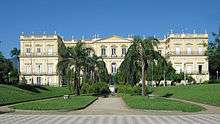 |
National Museum of Brazil | Quinta da Boa Vista in Rio de Janeiro | Brazil | 2018-09-02 | Not yet investigated. See National Museum of Brazil fire. Museum library was also destroyed. |
See also
References
- Fadhil, Muna (26 February 2015). "Isis destroys thousands of books and manuscripts in Mosul libraries". The Guardian. Retrieved 26 February 2015.
- "Arson ruled out". Home News. The Times (Final 3 ed.). London. 17 June 2005. p. 38.
A fire that destroyed a public library in Northam, Devon, was thought to have been the work of an arsonist, but investigators have determined that a beam from a hands-free magnifier ignited leaflets, which fell onto a box of books. Flames destroyed 90 per cent of the collection.
- TECHNICAL CONSERVATION, RESEARCH AND EDUCATION group (2007). Action C17: Built Heritage: Fire Loss to Historic Buildings: Final Report (PDF). Historic Scotland. p. 11. ISBN 978-1-904966-53-1.
- Fineberg, Gail. "Moving Toward a Safer Library. Compliance Office Issues Fire Safety Report," Library of Congress Information Bulletin 60 no. 3, 65, March 2001
- L.A., "Inspection Scorches Fire Safety at LC," American Libraries, 32 no. 3 17–18, March 2001
- Fixen, Edward L. and Vidar S. Landa,"Avoiding the Smell of Burning Data," Consulting-Specifying Engineer, May 2006, Vol. 39 Issue 5, p47-51
- Sima Qian. Records of the Grand Historian, Biography of Emperor Gaozu.
- The Alexandrian Library"
- "The Vanished Library by Bernard Lewis". Retrieved 5 December 2014.
- Dirk Rohmann, Christianity, Book-Burning and Censorship in Late Antiquity, (Walter de Gruyter GmbH, 2016), 240.
- Ann Christy, Christians in Al-Andalus:711–1000, (Curzon Press, 2002), 142.
- Libraries, Claude Gilliot, Medieval Islamic Civilization: L-Z, Index, ed. Josef W. Meri, Jere L. Bacharach, (Routledge, 2006), 451.
- "Moslem Libraries and Sectarian Propaganda", Ruth Stellhorn Mackensen, The American Journal of Semitic Languages and Literatures, Vol. 51, No. 2 (January , 1935), 93–94.
- C.E. Bosworth, The Later Ghaznavids, (Columbia University Press, 1977), 117.
- Steven Runciman, A History of the Crusades, Vol. II, (Cambridge University Press, 1999), 69.
- The Tomb of Omar Khayyâm, George Sarton, Isis, Vol. 29, No. 1 (July , 1938):16.
- Sen, Gertrude Emerson (1964) The Story of Early Indian Civilization. Orient Longmans
- Ibn Taymiyya, David Waines, The Islamic World, ed. Andrew Rippin, (Routledge, 2008), 382
- George Lane, Daily Life in the Mongol Empire, (Greenwood Press, 2006), 88.
- Robert S. Nelson, The Italian Appreciation and Appropriation of Illuminated Byzantine Manuscripts, Ca. 1200–1450, Dumbarton Oaks Papers 49 (1995): 209-210.
- Mercedes Garcia-Arenal Rodriquez and Fernando Rodríguez Mediano, The Orient in Spain: Converted Muslims, the Forged Lead Books of Granada, and the Rise of Orientalism, transl. Consuelo Lopez-Morillas, (Brill, 2013), 41.
- (DE)Edit Szegedi, Geschichtsbewusstsein und Gruppenidentität, (Bohlau Verlag, 2002), 223.
- "Jefferson's Legacy: A Brief History of the Library of Congress". Library of Congress. 2006-03-06. Retrieved 2008-01-14.
- Murray, Stuart (2009). The Library : An Illustrated History. New York, NY: Skyhorse Publishing. pp. 190–191. ISBN 978-1-60239-706-4.
- "Thomas Jefferson's Library". Library of Congress. Retrieved 10 March 2020.
- Tovar de Teresa, Guillermo (1990). La ciudad de los palacios: crónica de un patrimonio perdido, Volume 1. Editorial Vuelta. p. 14. ISBN 9789686258172.
- Báez, Guillermo (2013). Historia Universal de la Destrucción de Libros. OCEANO. pp. 220–222.
- Wolfe, Suzanne Rau (1983). The University of Alabama: A Pictorial History. Tuscaloosa, Alabama: The University of Alabama Press. pp. 57–59.
- R.J. Crampton, A Concise History of Bulgaria, (Cambridge University Press, 2006), 111.
- Bird, George W. (1897). Wanderings in Burma. London: F. J. Bright & Son. p. 254.
- Kramer, Alan (2008). Dynamic of Destruction: Culture and Mass Killing in the First World War. London: Penguin. ISBN 978-1-84614-013-6.Gibson, Craig (2008). "The culture of destruction in the First World War". Times Literary Supplement (January 30, 2008). Retrieved 2008-02-18.
- Hill, J. R. (2003). A New History of Ireland Volume VII: Ireland 1921–84. Oxford University Press. pp. Chapter II p2. ISBN 978-0-19-161559-7.
- Ferriter, Diarmaid (2010). The Limits of Liberty – Episode 1. RTÉ.
- Michael R. Godley, Review of The Life and Times of Zhang Yuanji, 1867-1959 by Manying Ip, in: Australian Journal of Chinese Affairs, No. 19/20 (Jan. - Jul., 1988), p. 416. Retrieved 15 August 2020.
- Board of Directors of the Oriental Library, A Description of the Oriental Library Before and After the Destruction by Japanese on February 1, 1932, Shanghai: Mercury Press, 1932, p. 5. Retrieved 15 August 2020.
- Ke Jiayun, "Bombed-out library with revolutionary past", Shanghai Daily. Retrieved 15 August 2020.
- Lost memory: libraries and archives destroyed in the twentieth century
- University of Louvain, International Dictionary of University Histories, ed. Carol J. Summerfield, Mary Elizabeth Devine, Anthony Levi, (Fitzroy Dearborn Publishers, 1998), 531.
- Dejan Ristić (3 April 2016). "Hitler je naredio: prvo uništiti Narodnu biblioteku" [Hitler ordered: first destroy the National Library]. Politika (in Serbian).
- Jelena Čalija, Dejan Ristić (15 March 2020). "Двоструко страдање Народне библиотеке Србије" [Double suffering of the National Library of Serbia]. Politika (in Serbian). p. 8.
- Rebecca Knuth (2006). Burning Books and Leveling Libraries: extremist violence and cultural destruction. Westport, Conn.: Praeger. p. 166. ISBN 0-275-99007-9.
- Knuth, Rebecca (2006-06-27). Destroying a Symbol: Checkered History of Sri Lanka's Jaffna Public Library (PDF). IFLA. Retrieved 2008-08-30.
- Kaur, Jaskaran; Crossette, Barbara (2006).|http://ensaaf-org.jklaw.net/publications/reports/20years/20years-2nd.pdf
- http://www.tribuneindia.com/2000/20000612/main7.htm
- The Smoking Gun Recovered, United Sikhs documentary"|https://www.youtube.com/watch?v=i6AFP1NiF-U
- The Central University Library of Bucharest, official site: "the History".
- "Legea recunoştinţei, made in Romania", Evenimentul Zilei, 03 June 2010.
- Collection of articles and studies on destruction of libraries and archives in Bosnia and Herzegovina (available for download in .pdf)
- Erasing the Past: The Destruction of Libraries and Archives in Bosnia-Herzegovina Archived 2012-01-18 at the Wayback Machine ()
- Crimes of war, crimes of peace: destruction of libraries during and after the Balkan wars of the 1990s ()
- Abkhazia: Cultural Tragedy Revisited Archived 2019-09-22 at the Wayback Machine, Caucasus Reporting Service, Institute for War and Peace Reporting
- Censorship of historical thought: a world guide, 1945–2000, Antoon de Baets
- Prized Iraqi annals 'lost in blaze' ()
- "Photos by Dr Saad Eskander of damage to Iraq National Library and Archive". Archived from the original on 27 April 2010. Retrieved 5 December 2014.
- "Pictures of Damaged Libraries in Iraq". Retrieved 5 December 2014.
- "MELA Committee on Iraqi Libraries". Retrieved 5 December 2014.
- "ICBS -Assessment of damage to Libraries and Archives in Iraq". Archived from the original on 14 August 2015. Retrieved 5 December 2014.
- Norton, Daniel; Henk, Mandy; Fagin, Betsy; Taylor, Jaime; Loeb, Zachary (Spring 2012). "OCCUPY WALL STREET LIBRARIANS SPEAK OUT" (PDF). Progressive Librarian. 38/39 (38/39): 3–16. Retrieved 21 October 2018.
- Un incendio durante los disturbios de El Cairo destruye el original de la 'Descripción de Egipto' encargada por Napoleón (Archived December 19, 2011, at WebCite)
- Harding, Luke (January 28, 2013). "Timbuktu mayor: Mali rebels torched library of historic manuscripts". The Guardian. Retrieved January 28, 2013.
- Walker, Peter (January 28, 2013). "Timbuktu library is treasure house of centuries of Malian history". The Guardian. Retrieved January 28, 2013.
- Fleeing Islamists burn priceless Timbuktu library Archived 2013-01-29 at the Wayback Machine, accessed 29 January 2013
- Lor, Pieter (2013). "Burning Libraries for the People: Questions and Challenges for the Library Profession in South Africa" (PDF). Libri. 6 (4): 359–372. doi:10.1515/libri-2013-0028. Retrieved 22 July 2020.
- Andrew Nikiforuk (30 December 2013). "Secret Memo Casts Doubt on Feds' Claims for Science Library Closures: Goal stated is 'culling' research, not preserving and sharing through digitization". The Tyee.
- "Irreplaceable research lost from purged federal libraries: BC Green Party MLA Andrew Weaver says government didn't digitize entire libraries as promised". News1130. 6 January 2014.
- "Lebanon Loses 78000 Books To Terrorism: Tripoli's "Al Sa'eh" Library Burned". Archived from the original on 2014-01-05.
- "Thousands of books, manuscripts torched in fire at historic Lebanese library".
- "Tripoli Figures Condemn Torching Famed Library as Father Sarrouj 'Forgives Attackers'". Archived from the original on 2014-01-05.
- "20 Pictures Of Al Sa'eh Library in Tripoli Before It Got Torched". Archived from the original on 2014-01-05.
- "Custody of the Suspects Hatibović and Trnka terminated and prohibiting measures ordered". Court of Bosnia & Herzegovina. 7 April 2014. Retrieved 13 December 2014.
- "Sedmorica osumnjičena za paljenje Predsjedništva i Arhiva BiH" (in Croatian). tportal.hr. 9 March 2014. Retrieved 13 December 2014.
- "Ogromna šteta, dio dokumentacije nepovratno uništen". tportal.hr. 13 February 2014. Retrieved 19 February 2014.
- "Nepovratno uništen deo Arhiva BiH". B92. 13 February 2014. Retrieved 19 February 2014.
- "Direktor Arhiva BiH tvrdi: Izgorjelo je 60 posto depoa". Oslobođenje. 13 February 2014. Archived from the original on 23 February 2014. Retrieved 17 February 2014.
- ""داعش" يحرق آلاف الكتب في الموصل والأنبار". elaph.com. 23 February 2015. Retrieved 22 February 2015.
- "A Moscow library containing rare UN documents, ancient Slavic texts, and 14 million books is on fire". QUARTZ. 30 January 2015. Retrieved 31 January 2015.
- "ISIS Burns 8000 Rare Books and Manuscripts in Mosul". Yahoo Finance (The Fiscal Times). 23 February 2015. Retrieved 25 February 2015.
- Biblioteca Nacional Rubén Darío Archived 2011-10-04 at the Wayback Machine (in Spanish)
- Notes on the history of Birmingham Public Libraries (1861–1961), Birmingham, 1962
- Charles A. Halbert Public Library ( Archived August 17, 2012, at WebCite)
- "The Buildings of Dalhousie University – Weldon Law Building – Building History". Library.dal.ca. 1967-03-18. Archived from the original on 2016-01-07. Retrieved 2015-07-10.
- "April 29 Marks 30th Anniversary of 1986 Fire". Los Angeles Public Library. Retrieved 13 March 2020.
- Парфенов, Леонид. Намедни. Наша эра. 1981–1990 (in Russian). p. 209.
- "Leningrad Library Fire". Abbey Newsletter. Jun 1988. Retrieved 23 May 2014.
- BBC Website – On This Day 1 August
- "Norwich Central Library fire 25 years on". BBC News. Retrieved 14 March 2020.
- Walker, Peter. "Glasgow School of Art fire: fire damages Charles Rennie Mackintosh building - as it happened". The Guardian. Retrieved 13 March 2020.
- Brooks, Libby. "Glasgow School of Art fire caused by gases from foam canister, says report". The Guardian. Retrieved 13 March 2020.
- Solly, Meilan. "Glasgow School of Art Will Be Rebuilt, But Construction Could Last Up to a Decade". Smithsonian Magazine. Retrieved 13 March 2020.
- "Mzuni library completely destroyed by fire". The Maravi Post. 18 December 2015. Retrieved 19 December 2015.
- Dube, Gift Alfred B.; Kanyundo, Allan J.; Majawa, Felix P. "COPING WITH THE FIRE DISASTER AT MZUZU UNIVERSITY: EXPERIENCES FROM LIBRARIANS AND STUDENTS" (PDF). Scecsal. Retrieved 14 March 2020.
Further reading
- The Bosnian Manuscript Ingathering Project – A call for Bosnian manuscripts ingathering
- Polastron, Lucien X. (2007) Libros en Llamas: historia de la interminable destrucción de bibliotecas. Libraria, ISBN 968-16-8398-6.
- Knuth, Rebecca. Libricide : the regime-sponsored destruction of books and libraries in the twentieth century. ISBN 0-275-98088-X
- Polastron, Lucien X. Books on fire: the destruction of libraries throughout history. ISBN 978-1-59477-167-5
- Civallero, Edgardo. When Memory Turns into Ashes... Memoricide During the XX Century. DOI.
- UNESCO. Lost Memory – Libraries and archives destroyed in the twentieth century
- Books on Fire: The Destruction of Libraries Throughout History. Lucien Xavier Polastron. Translated by John E Graham. Inner Traditions. ISBN 978-1-59477-167-5. ISBN 1-59477-167-7.